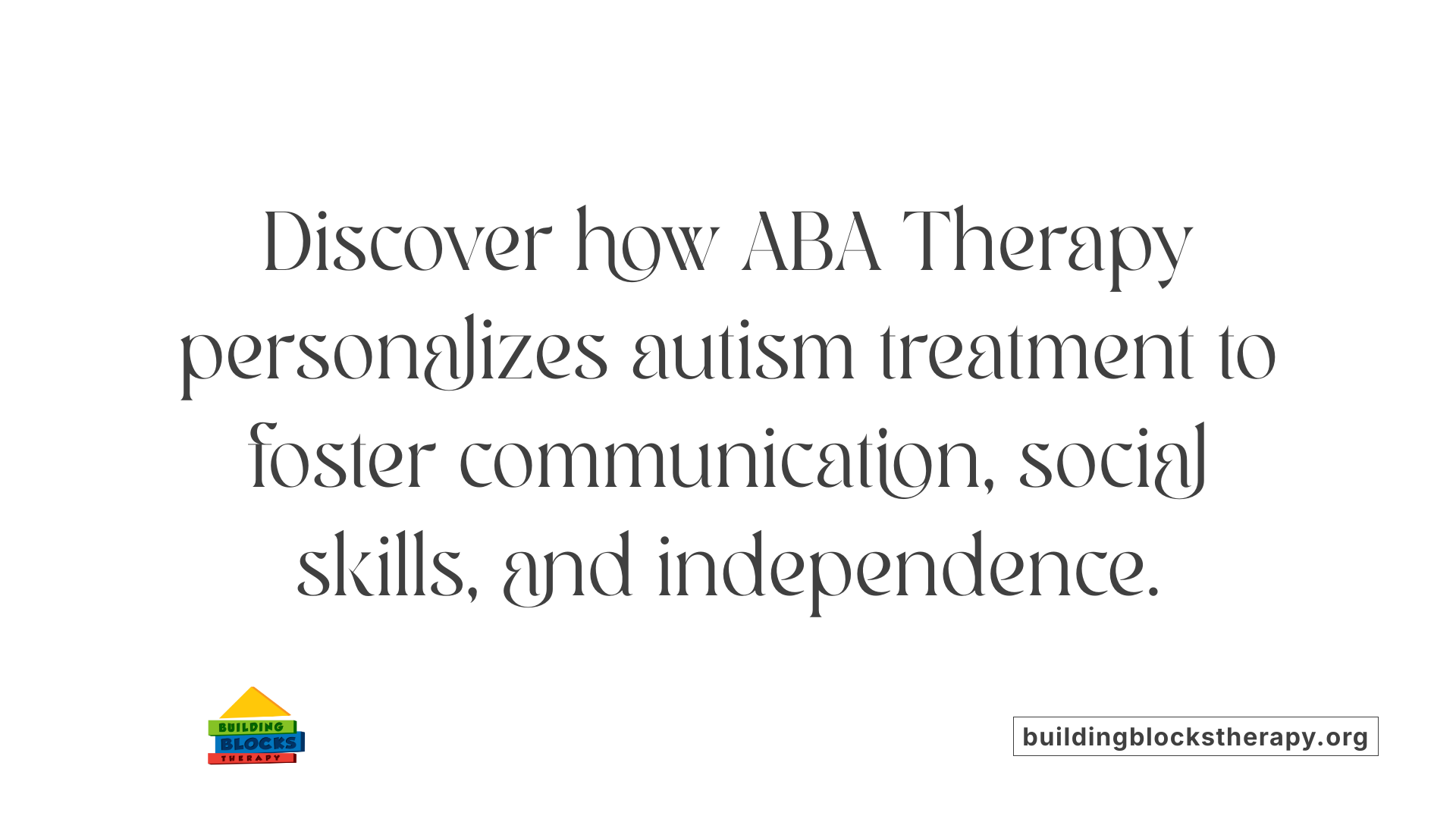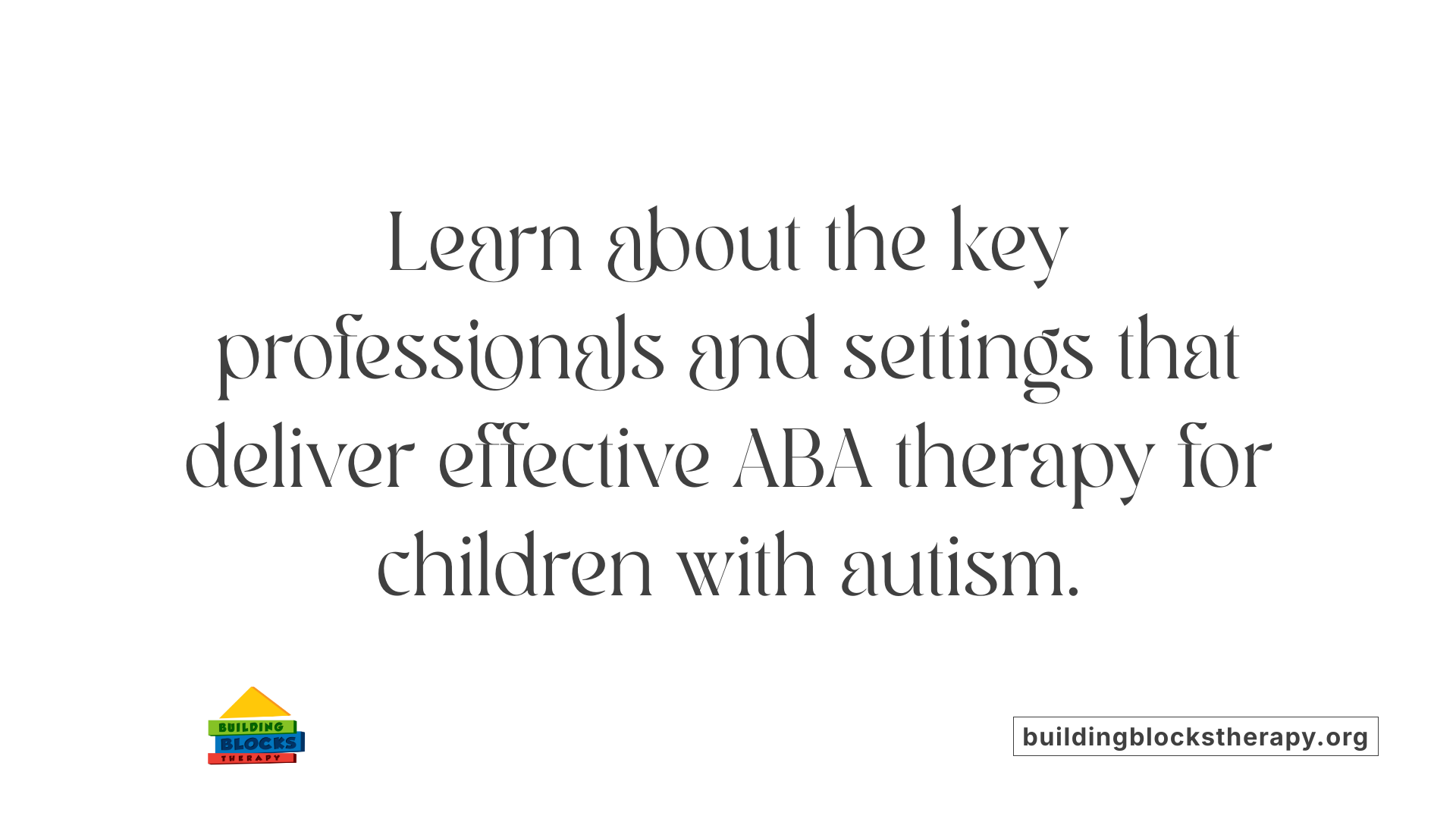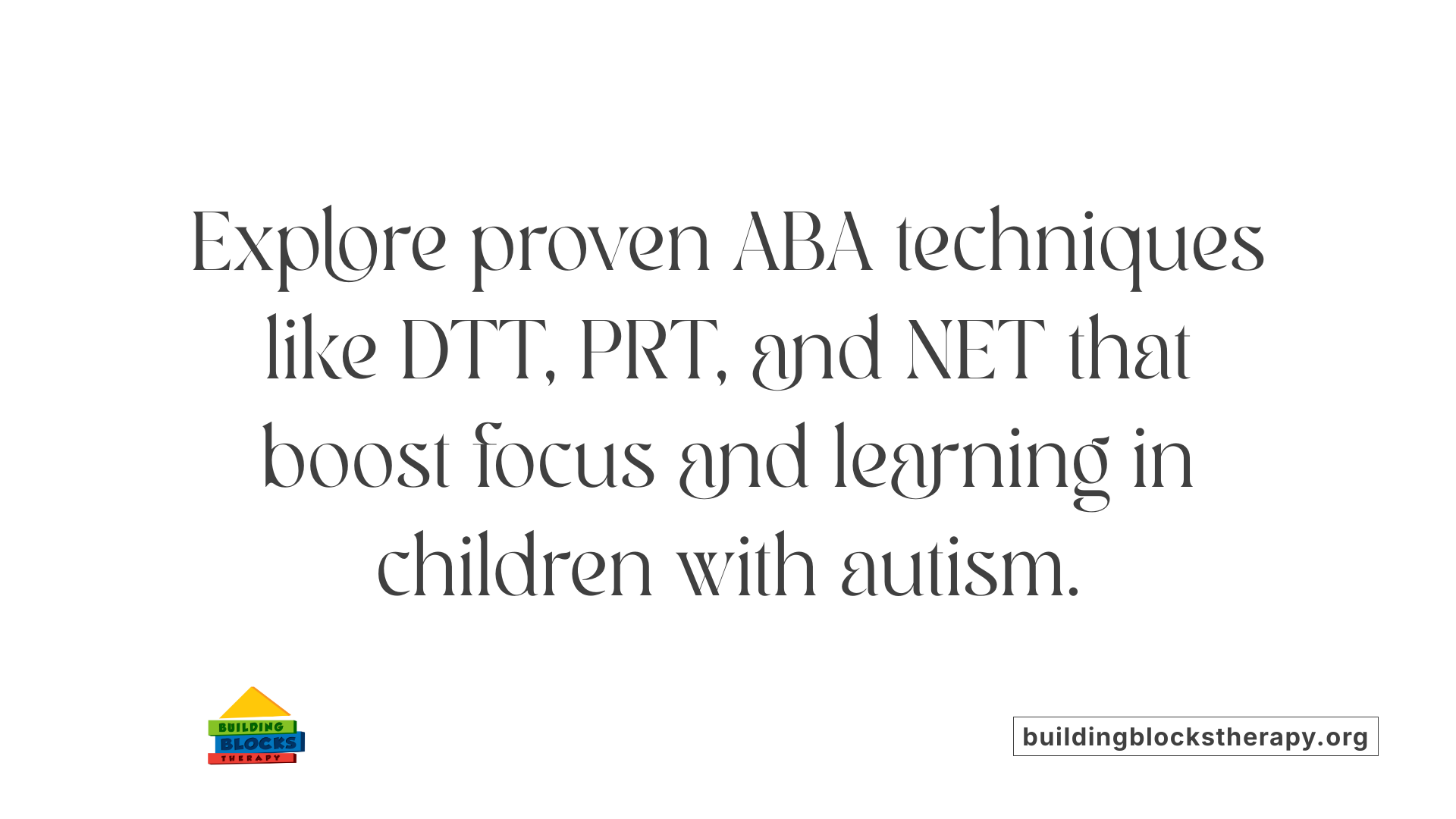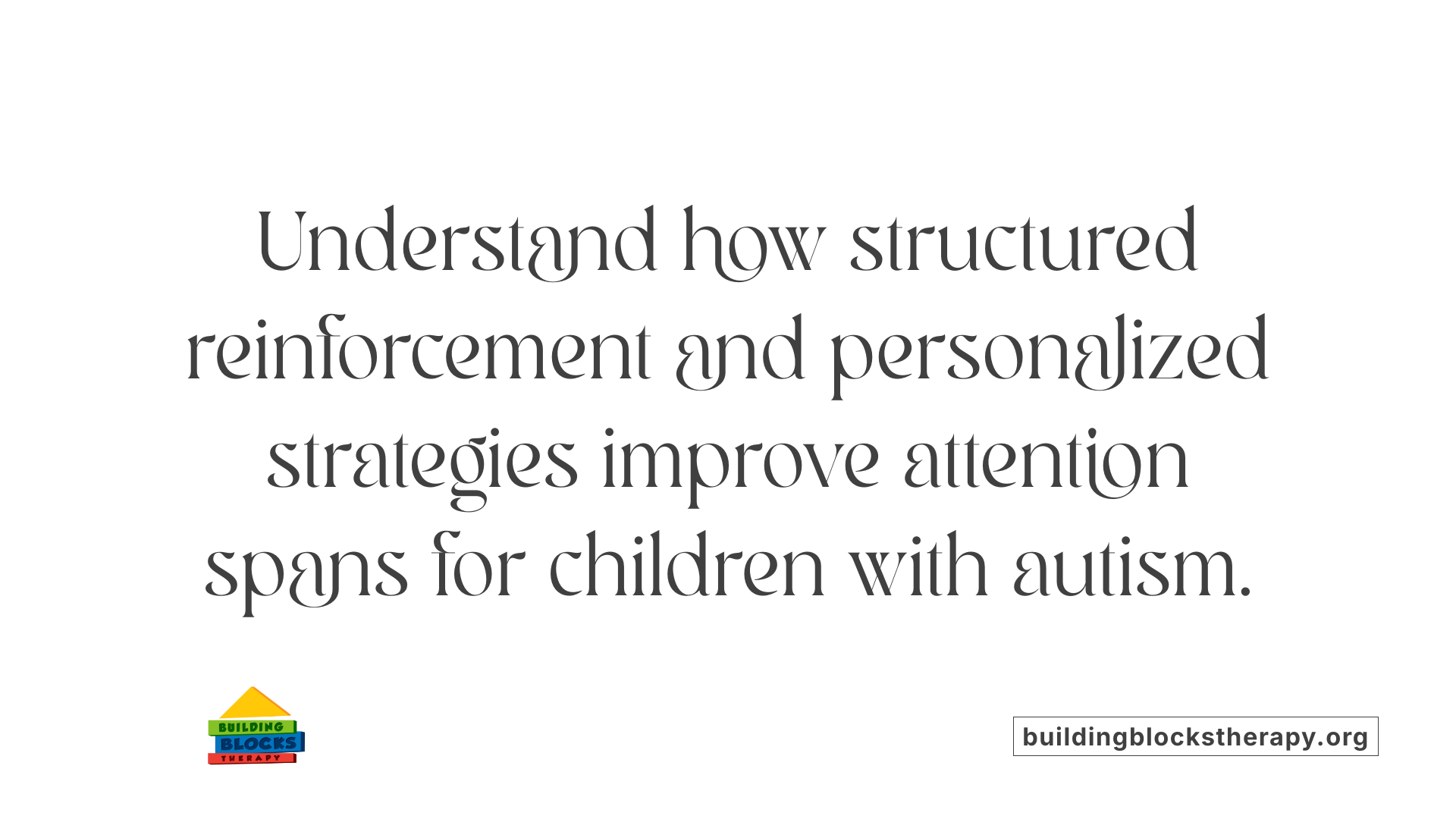Understanding ABA Therapy and Its Role in Autism
Applied Behavior Analysis (ABA) therapy is a proven, science-based approach focused on improving behavior and learning outcomes for children with autism spectrum disorder (ASD). By harnessing the principles of behavior analysis and learning theory, ABA therapy helps children develop vital skills such as improved focus, communication, and social interaction. This article explores how ABA therapy supports children with autism in enhancing their concentration and attention through tailored, evidence-based interventions delivered by qualified professionals.
What Is Behavioral Therapy for Autism?

Explanation of behavioral therapy for autism
Behavioral therapy for autism mainly centers on Applied Behavior Analysis (ABA), a scientifically backed approach focused on using the principles of behavior and learning to develop positive skills and reduce challenging behaviors. ABA therapy is tailored to each child's unique needs and targets improvements in communication, social interaction, self-care, and academics. It typically involves trained professionals, including board-certified behavior analysts (BCBAs) and therapists, who design and oversee personalized treatment plans.
Core ABA principles and techniques
ABA functions through the systematic analysis of behavior by examining its antecedents and consequences (known as the 'A-B-Cs'). Repetition of positive behaviors is encouraged through reinforcement, primarily positive reinforcement, which rewards desired actions to increase their frequency. Other techniques include prompting, shaping, discrete trial training, pivotal response training, and natural environment training—all designed to help children learn and generalize new skills across settings.
Role of positive reinforcement and individualized programming
Positive reinforcement is central in ABA therapy; children receive praise, rewards, or other incentives when they demonstrate target behaviors, which encourages learning and retention. The therapy is individualized, involving continuous data collection and assessment by BCBAs to adapt goals and ensure effective progress monitoring. This personalized approach ensures therapy matches each child’s strengths, interests, and developmental needs.
Integration with supplementary therapies
ABA often integrates with additional therapies such as speech-language therapy, occupational therapy, and social skills training. These combined approaches address the comprehensive needs of children with autism, fostering growth in communication, fine motor skills, emotional regulation, and everyday functional abilities. Early initiation of ABA therapy, especially before age three to six, can yield significant developmental improvements by leveraging brain plasticity during early childhood.
Who Provides Behavioral Therapy for Autism?

Key Professionals Involved in ABA Therapy
Behavioral therapy for autism is chiefly provided by licensed professionals specializing in Applied Behavior Analysis (ABA). The most prominent among these are Board Certified Behavior Analysts (BCBAs), who design, supervise, and monitor tailored ABA programs. Other professionals include psychologists and trained support staff such as Registered Behavior Technicians (RBTs), who implement daily therapy sessions under the guidance of a BCBA.
Roles of BCBAs and Support Staff
BCBAs are responsible for developing individualized treatment plans based on thorough assessments like Functional Behavior Assessments (FBAs). They analyze behaviors, identify triggers (antecedents), and determine consequences to effectively promote skill acquisition and behavior change. Support staff and therapists conduct direct therapy, applying techniques such as positive reinforcement, prompting, and shaping to enhance communication, social skills, and daily living abilities.
Settings Where ABA Therapy Is Delivered
ABA therapy is delivered in various environments to ensure skills generalize across real-life situations. These settings include specialized clinics, schools, homes, and community environments. Early intervention programs frequently operate before age six and incorporate intensive therapy hours. Additionally, group sessions help improve social interaction and peer skills.
Parent and Caregiver Involvement
Parents and caregivers play a vital role in ABA therapy success. Professionals provide coaching and training to equip families with strategies to reinforce learning in natural settings, strengthening progress beyond therapy sessions. Collaborative involvement ensures consistency and helps address behaviors across contexts.
Behavioral therapy for autism, therefore, is a comprehensive effort led by qualified BCBAs and supported by a dedicated team, delivered in diverse settings with active family participation to maximize developmental outcomes.
Fundamental ABA Techniques Enhancing Focus in Children with Autism

Positive Reinforcement and Its Role in Skill Acquisition
Applied Behavior Analysis (ABA) therapy uses positive reinforcement to encourage children with autism to learn new skills. This involves rewarding desirable behaviors, such as increased attention or communication efforts, to make these behaviors more likely to happen again. Praise, tokens, or small rewards are often used to reinforce focus and participation during therapy.
Discrete Trial Training and Pivotal Response Training
Discrete Trial Training (DTT) is a structured ABA method that breaks down skills into small, teachable units delivered in clear, repeated trials. It helps children improve attention by providing consistent, focused learning opportunities. On the other hand, Pivotal Response Training (PRT) is a naturalistic and motivational approach emphasizing communication and social skills. PRT is less structured, working through play and real-life situations to maintain engagement and enhance focus.
Early Start Denver Model and Natural Environment Training
The Early Start Denver Model (ESDM) combines behavioral and developmental principles for children aged 12 to 60 months, delivering therapy in natural settings to promote learning through daily interactions and play. Natural Environment Training (NET) complements this by using everyday activities to teach skills, making learning more meaningful and improving children's attention spans by incorporating their interests and routines.
Functional Behavior Assessments Identifying Behavior Triggers
ABA therapy includes conducting Functional Behavior Assessments (FBAs) to identify what causes and maintains problem behaviors. Understanding antecedents and consequences (the "A-B-Cs") helps tailor interventions to minimize distractions and triggers, thereby supporting improved focus and self-regulation.
| ABA Technique | Description | Role in Enhancing Focus |
|---|---|---|
| Positive Reinforcement | Rewards desired behaviors to increase their occurrence | Encourages sustained attention and participation |
| Discrete Trial Training (DTT) | Structured, step-by-step teaching of skills | Builds focus through repetition and clear expectations |
| Pivotal Response Training (PRT) | Play-based, naturalistic approach focused on motivation | Enhances engagement in meaningful activities |
| Early Start Denver Model (ESDM) | Combines behavioral and developmental approaches in natural settings | Uses play and interaction to develop attention and skills |
| Natural Environment Training (NET) | Learning through everyday activities | Maintains focus by incorporating interests and familiar contexts |
| Functional Behavior Assessments (FBA) | Analyze behavior triggers and outcomes | Reduces distractions and problem behaviors |
How ABA Therapy Improves Focus and Attention in Children with Autism

Enhancing attention span through structured reinforcement
ABA therapy uses positive reinforcement techniques to gradually increase a child's attention span. By rewarding focused behavior, therapists encourage children to maintain attention during activities. This structured approach systematically builds the ability to stay engaged by linking attention to positive outcomes such as praise or tangible rewards.
Managing sensory input and impulsivity
Children with autism often experience challenges managing sensory input and controlling impulses. ABA addresses these through individualized strategies that help children recognize triggers and apply self-regulation techniques. Therapists use behavior analysis to understand antecedents and consequences, guiding children to reduce impulsive actions and better tolerate sensory experiences.
Tailoring interventions to individual strengths and needs
ABA therapy is highly customized. Each program is designed by a Board Certified Behavior Analyst (BCBA) to match the child's unique strengths, interests, and processing style. By aligning interventions with individual needs, ABA maximizes skill acquisition and addresses attention difficulties more effectively.
Promoting consistency and skill generalization across environments
ABA emphasizes consistency in applying therapeutic techniques across different settings—including home, school, and community—to help children generalize their attention skills. This consistent reinforcement ensures that improvements in focus and impulse control transfer to real-life situations, supporting better overall functioning.
Overall, ABA therapy improves focus and attention in children with autism by combining reinforcement-based attention training with personalized, consistent interventions. These methods help children develop sustained attention, manage sensory challenges, and control impulses, leading to meaningful progress in learning and daily functioning.
Benefits of ABA Therapy Beyond Focus Enhancement
How Does ABA Improve Communication and Social Skills?
ABA therapy utilizes techniques such as positive reinforcement, prompting, and shaping to enhance communication abilities. Children with autism learn to express themselves through methods like picture exchange and symbols. Additionally, social skills are developed by teaching children to understand social cues, cooperate, and communicate effectively with peers. Group therapy settings in ABA promote socialization, helping children make friends and reduce feelings of isolation.
What Independent Living Skills Can ABA Foster?
ABA therapy extends beyond social and communication improvements to foster essential life skills. These include fine motor skills, personal hygiene, grooming, and practical tasks such as cooking, cleaning, and shopping. By tailoring ABA programs to individual needs, children and adults with autism can learn how to use assistive devices and strategies that support independence in daily living activities.
How Does ABA Help Reduce Problematic Behaviors?
Through functional behavior assessments, ABA identifies triggers (antecedents) and consequences of behaviors. By applying positive reinforcement, ABA decreases harmful or disruptive behaviors and increases helpful and socially appropriate behaviors. This systematic approach helps children better manage impulses, sensory input, and repetitive behaviors, resulting in improved emotional regulation and a more constructive response to environmental challenges.
What is the Long-Term Impact of ABA on Quality of Life?
Early intensive ABA intervention, typically between ages 2 and 6, significantly improves long-term outcomes. Supported areas include socialization, expressive language, intellectual functioning, and adaptive daily living skills. Research shows that improved communication and behavioral regulation foster greater independence and social success throughout life. Although more large-scale studies on long-term quality of life are needed, consistent evidence suggests ABA therapy equips individuals with autism to handle real-life situations more effectively and enjoy a better overall quality of life.
The Critical Role of Early and Intensive ABA Intervention

Impact of early intervention on developmental outcomes
Early and intensive ABA therapy plays a crucial role in shaping the developmental trajectory of children with autism spectrum disorder (ASD). When introduced, typically between ages 2 to 6, this intervention leverages the plasticity of the young brain to foster improvements in socialization, communication, and expressive language. Early engagement helps children acquire foundational skills that set the stage for future learning and adaptive behavior.
Intensity and duration of ABA therapy sessions
The effectiveness of ABA therapy is closely linked to the intensity and duration of treatment. Intensive programs often involve 20–40 hours per week, sustained over months or years, to maximize skill acquisition and behavioral improvements. This consistent, focused approach allows for repeated learning opportunities and timely adjustments based on progress.
Models like Early Intensive Behavioral Intervention (EIBI)
Among various models, Early Intensive Behavioral Intervention (EIBI) is a prominent comprehensive ABA framework tailored for children under five years old. EIBI combines structured teaching with individualized goals encompassing communication, social skills, and adaptive behaviors. Other notable models include the Early Start Denver Model (ESDM), which integrates naturalistic teaching and developmental strategies for children aged 12 to 60 months. These models emphasize early, personalized intervention to support diverse learning needs.
Evidence supporting early focused ABA treatment
Research consistently demonstrates that early, focused ABA intervention improves a range of developmental outcomes. Over 20 studies have reported gains in intellectual functioning, language development, daily living skills, and social competence. While many studies employ small sample sizes and single-case designs, the majority (63–88%) show positive effects. Governments and professional bodies, such as the US Surgeon General and the American Psychological Association, endorse ABA as a best practice treatment, underlining the clinical significance of early and intensive application.
| Aspect | Description | Impact on Children with ASD |
|---|---|---|
| Age of Intervention | Ideally between 2 to 6 years | Enhances brain plasticity for skill development |
| Intensity & Duration | 20–40 hours weekly in intensive models like EIBI | Sustained learning and behavioral improvement |
| ABA Models | Early Intensive Behavioral Intervention (EIBI), Early Start Denver Model (ESDM), LEAP program | Customized approaches improve communication and social skills |
| Evidence Base | Over 20 studies showing improved cognitive, language, and adaptive outcomes | Strong scientific support with professional endorsements |
Overall, starting ABA therapy early and with sufficient intensity profoundly supports children with ASD in acquiring essential skills, promoting better long-term developmental outcomes.
Data-Driven Progress Monitoring and Program Adaptation
Use of Data Collection and Ongoing Assessment
ABA therapy relies heavily on systematic data collection to track a child's progress over time. Therapists and Board Certified Behavior Analysts (BCBAs) gather detailed information on behaviors, skills acquisition, and responses to interventions. This continuous assessment enables them to objectively evaluate the effectiveness of specific techniques and identify areas requiring modification.
Role of Board Certified Behavior Analysts (BCBAs) in Supervising Therapy
BCBAs are professionals specially trained and certified to design, oversee, and adjust ABA therapy programs. They analyze collected data to ensure that treatment goals are appropriate and effective. Their supervision includes conducting functional behavior assessments (FBAs), making informed clinical decisions, and guiding therapists or Registered Behavior Technicians (RBTs) in implementing tailored interventions.
Functional Behavior Assessments Guiding Targeted Interventions
Functional Behavior Assessments are integral to understanding the antecedents and consequences influencing a child's behavior. By identifying behavior triggers and outcomes, BCBAs can develop interventions to increase helpful behaviors and reduce problematic ones. These assessments help ensure that therapy addresses the specific needs and motivations of each individual.
Adjusting Therapy to Maximize Individual Progress
ABA is highly individualized; based on ongoing data and behavioral analysis, therapy plans are continually refined. Adjustments might include altering reinforcement strategies, changing the focus of skill-building activities, or introducing new teaching methods. This dynamic approach ensures therapy remains effective and aligned with each child’s evolving strengths, interests, and challenges.
Group and Natural Environment Training to Foster Focus and Social Skills
How Does Group Therapy Benefit Socialization?
Group therapy in ABA creates a supportive space for children to practice social skills, cooperation, and communication with peers. This setting encourages making friendships, reducing feelings of isolation, and helping children manage agitation. Through guided interactions, children learn appropriate social cues and how to take turns, promoting more meaningful group participation.
What Is Natural Environment Teaching and Why Is It Important?
Natural Environment Teaching (NET) incorporates learning opportunities into everyday routines and play, ensuring that skills acquired during therapy transfer smoothly to real-life situations. NET promotes generalization by basing training in contexts a child naturally encounters, making learned behaviors more functional and easier to maintain outside the therapy setting.
How Does Play Therapy Aid Emotional Regulation?
Play therapy within ABA uses structured and unstructured play to help children express and manage their emotions constructively. It supports the development of emotional skills such as recognizing feelings, coping with frustration, and communicating needs. This approach increases a child’s ability to handle stress and interact positively with others.
How Does ABA Support Real-World Coping and Communication Skills?
ABA therapy prepares children to handle everyday situations by teaching behavioral management, self-care, and social understanding. Techniques like prompting and reinforcement help children learn to interpret social cues, express themselves, and adapt behaviors in various settings. These skills boost confidence and independence while improving communication and emotional responses.
Group therapy, NET, and play therapy are interconnected components of ABA that together foster focus, social engagement, and adaptive skills essential for daily life and learning environments.
Challenges and Limitations Within ABA Research and Practice
What Are Current Research Limitations in ABA Therapy?
Despite the strong evidence supporting Applied Behavior Analysis (ABA) therapy, current research faces several limitations. Most studies involve small sample sizes, often with a median of only three participants. These single-case experimental designs (SCEDs) provide individualized treatment insights but limit the generalizability of findings across broader populations. Additionally, only a small percentage of studies include randomized controlled trials (RCTs) that directly compare ABA to other treatments.
Why Is There a Scarcity of Long-Term Quality of Life Studies?
There is a notable lack of research focusing on the long-term effects of ABA therapy, especially concerning quality of life (QoL) for children with autism and their families. Most existing studies concentrate on short-term outcomes like cognitive and behavioral improvements, with fewer assessing lasting impacts into adulthood. This gap leaves uncertainties about potential adverse effects and sustained benefits over time.
How Do Outcomes Vary Among Different ABA Techniques?
Research comparing different ABA methods reveals mixed results. While some interventions perform better in specific areas, no single technique has proven universally superior across all developmental outcomes. This diversity illustrates the need for personalized approaches but complicates the identification of the most effective practices.
What Are Future Directions for ABA Research?
The field calls for more large-scale, long-term, prospective studies that include comprehensive outcome measures such as quality of life and functional gains. Future research should prioritize standardized assessments and larger participant pools to better understand sustained treatment effects. Incorporating diverse populations and exploring variations in therapy delivery will help optimize ABA efficacy and accessibility.
| Challenge | Description | Impact on ABA Practice |
|---|---|---|
| Small Sample Sizes | Majority of studies have very few participants | Limits generalizability of results |
| Scarcity of Long-Term QoL Studies | Few studies assess lasting outcomes, especially into adulthood | Uncertain long-term benefits and risks |
| Diverse Outcomes Among Techniques | No single ABA method excels across all outcome categories | Necessitates personalized intervention planning |
| Need for Large-Scale Studies | Most research lacks extensive, prospective design | Calls for improved evidence to guide practice |
Accessing ABA Therapy: What Families Should Know
Insurance Coverage for ABA Therapy
Insurance coverage for ABA therapy varies widely. Many private insurance plans and Medicaid programs cover ABA services when a healthcare professional has deemed them medically necessary. Families should check with their insurance providers to understand specific coverage details and requirements. Some policies require prior authorization or documentation of a child's diagnosis and need for therapy.
Finding Qualified ABA Providers
Finding the right ABA provider begins with verifying credentials. Look for therapists supervised by a Board Certified Behavior Analyst (BCBA), who designs and oversees the individualized therapy programs. Registered Behavior Technicians (RBTs) often deliver therapy sessions under BCBA supervision. Ensure that all providers have up-to-date certification and experience working with children with autism spectrum disorder (ASD).
Personalized Therapy Matching Child Needs
ABA therapy is highly individualized. Successful programs are tailored based on each child's unique strengths, challenges, interests, and communication style. Early and intensive intervention can significantly improve communication, social skills, and independence. Families should seek providers who conduct thorough assessments and customize goals across areas such as language, social interaction, self-care, and academics.
Resources and Support for Families
Many organizations and websites offer guidance on locating qualified ABA providers and insurance options. Families can also find support groups and advocacy resources that help navigate therapy choices and financial assistance. Consulting with experienced professionals or patient advocacy services can provide personalized advice and improve access to effective ABA services.
ABA Therapy: Empowering Focus and Growth in Children with Autism
Applied Behavior Analysis therapy represents a scientifically grounded and highly individualized approach to supporting children with autism in enhancing their focus and broader developmental skills. Delivered by certified professionals, ABA employs a range of techniques incorporating positive reinforcement and behavior modification principles tailored to each child's unique profile. While research confirms the efficacy of ABA in improving attention, communication, and social functioning, ongoing studies aim to deepen understanding of long-term outcomes and quality of life impacts. Early, intensive therapy coupled with careful data-driven adaptation ensures that children receive targeted support to thrive across environments. Families seeking ABA therapy should prioritize qualified providers and understand insurance options to maximize access to this transformative intervention. Ultimately, ABA empowers children with autism to build essential life skills, fostering greater independence and improved quality of life.
References
- Applied Behavior Analysis (ABA)
- 6 Benefits of ABA Therapy for Children with Autism
- Applied Behavior Analysis in Children and Youth with Autism ...
- The Benefits Of ABA Therapy for Autism
- 5 Benefits of ABA Therapy for Autistic Child
- Behavioral Therapy for Autism Spectrum Disorder in ...
- Treatment and Intervention for Autism Spectrum Disorder
- Behavioral Management Therapy for Autism | NICHD
- Autism Therapy Types & Interventions






